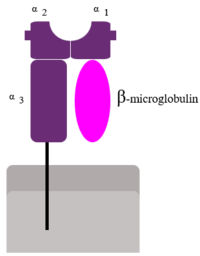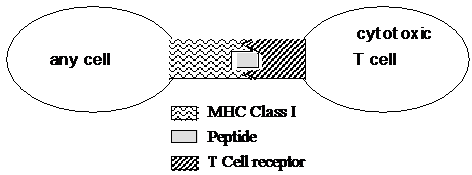User:Jeremiah C Hagler/Sandbox 2
From Proteopedia
(Difference between revisions)
| Line 1: | Line 1: | ||
==Protein 1: MHC Class I== | ==Protein 1: MHC Class I== | ||
| - | |||
<StructureSection load='1hhk' size='340' side='right' caption='MHC Class I' scene=''> | <StructureSection load='1hhk' size='340' side='right' caption='MHC Class I' scene=''> | ||
| - | |||
== Background Information == | == Background Information == | ||
Major Histocompatibility Complex Class I (abbreviated for obvious reasons as MHC Class I) is a key component of your immune system. The protein is a glycoprotein (protein with a sugar attached) present on all cells in your body. Its function is to show peptides (short stretches of 9-10 amino acids), both self and foreign, to the immune system. This presentation helps the immune system determine whether the body has been infected by a foreign agent (bacteria or virus). When the body is not infected with a pathogen, peptides derived from normal proteins present in your cells are presented on the Class I MHC molecule (these peptides are known as “self” peptides). These peptide-MHC combinations are ignored by the immune system, as the cells of the immune system (mainly T-cells) have been “trained” to not react to self peptides present on the MHC. However, when the body is infected with a pathogen like a virus, cells are commandeered by the virus to produce large amounts of viral proteins that will be used to make new virus. Some of these proteins are broken down by the cell into peptides, and presented on the Class I MHC molecule (these are known as “foreign” peptides). T-cells, the cells that recognize MHC Class I complexed with peptide, are trained to recognize only those MHC Class I molecules that are presenting foreign peptides--such as these protein pieces from the viral invader. The MHC Class I + foreign peptide complex is recognized differently and is key to developing an effective immune response against the pathogenic invader. | Major Histocompatibility Complex Class I (abbreviated for obvious reasons as MHC Class I) is a key component of your immune system. The protein is a glycoprotein (protein with a sugar attached) present on all cells in your body. Its function is to show peptides (short stretches of 9-10 amino acids), both self and foreign, to the immune system. This presentation helps the immune system determine whether the body has been infected by a foreign agent (bacteria or virus). When the body is not infected with a pathogen, peptides derived from normal proteins present in your cells are presented on the Class I MHC molecule (these peptides are known as “self” peptides). These peptide-MHC combinations are ignored by the immune system, as the cells of the immune system (mainly T-cells) have been “trained” to not react to self peptides present on the MHC. However, when the body is infected with a pathogen like a virus, cells are commandeered by the virus to produce large amounts of viral proteins that will be used to make new virus. Some of these proteins are broken down by the cell into peptides, and presented on the Class I MHC molecule (these are known as “foreign” peptides). T-cells, the cells that recognize MHC Class I complexed with peptide, are trained to recognize only those MHC Class I molecules that are presenting foreign peptides--such as these protein pieces from the viral invader. The MHC Class I + foreign peptide complex is recognized differently and is key to developing an effective immune response against the pathogenic invader. | ||
Revision as of 17:16, 13 September 2015
Protein 1: MHC Class I
| |||||||||||


